Dry-mixed mortar sand making equipment is designed to produce high-quality artificial sand or fine aggregates specifically for dry-mixed mortar applications. This equipment ensures the sand meets strict particle size, gradation, and cleanliness standards required for mortar formulations. Below are key aspects of such systems:

1. Core Equipment for Dry-Mixed Mortar Sand Production
– Crushers:
– *Jaw Crusher*: Primary crushing of raw materials (e.g., limestone, granite).
– *Impact Crusher* or *Cone Crusher*: Secondary crushing to achieve finer particles.
– *Vertical Shaft Impact (VSI) Crusher*: Critical for shaping sand particles and improving gradation (cubic-shaped grains reduce mortar shrinkage).
– Sand Making Machine:
– Uses a “stone-on-stone” or “stone-on-iron” principle to produce sand with adjustable fineness modulus (typically 1.2–3.0 for mortar).
– Screening System:
– *Vibrating Screens*: Separate sand into different fractions (e.g., 0–0.6 mm, 0.6–1.18 mm, 1.18–2.36 mm) to meet mortar mix designs.
– *Air Classifiers*: Optional for ultra-fine particle control (<75 μm).
– Sand Washing & Dewatering:
– *Wheel Sand Washer* or *Spiral Classifier*: Removes clay, dust, and impurities (critical for bond strength in mortar).
– *Dewatering Screen* or *Fine Sand Recovery Unit*: Reduces moisture content (<3% for dry-mixed mortar).
2. Key Features of High-Quality Mortar Sand
– Particle Shape: Cubic or spherical grains enhance workability and reduce water demand.
– Gradation Control: Balanced distribution (e.g., complying with ASTM C144 or EN 13139).
– Low Clay/Silt Content: <3% to avoid cracking and poor adhesion.
– Moisture Control: <0.5% moisture after drying (to prevent clumping in dry mixes).

3. Auxiliary Systems
– Drying System:
– *Rotary Dryer*: Reduces moisture in natural or crushed sand using hot air (fuel options: gas, coal, biomass).
– Dust Collection:
– *Bag Filters* or *Cy
Leave a Reply